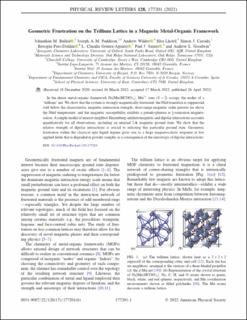| dc.contributor.author | Bulled, Johnathan M. | |
| dc.contributor.author | Paddison, Joseph A. M. | |
| dc.contributor.author | Wildes, Andrew | |
| dc.contributor.author | Lhotel, Elsa | |
| dc.contributor.author | Cassidy, Simon J. | |
| dc.contributor.author | Pato-Doldán, Breogán | |
| dc.contributor.author | Gómez-Aguirre, L. Claudia | |
| dc.contributor.author | Saines, Paul J. | |
| dc.contributor.author | Goodwin, Andrew L. | |
| dc.date.accessioned | 2023-01-23T12:59:39Z | |
| dc.date.available | 2023-01-23T12:59:39Z | |
| dc.date.created | 2022-10-19T11:20:20Z | |
| dc.date.issued | 2022 | |
| dc.identifier.issn | 0031-9007 | |
| dc.identifier.uri | https://hdl.handle.net/11250/3045358 | |
| dc.description.abstract | In the dense metal-organic framework Na[Mn(HCOO)3], Mn2+ ions (S=52) occupy the nodes of a “trillium” net. We show that the system is strongly magnetically frustrated: the Néel transition is suppressed well below the characteristic magnetic interaction strength; short-range magnetic order persists far above the Néel temperature; and the magnetic susceptibility exhibits a pseudo-plateau at 13-saturation magnetization. A simple model of nearest-neighbor Heisenberg antiferromagnetic and dipolar interactions accounts quantitatively for all observations, including an unusual 2-k magnetic ground state. We show that the relative strength of dipolar interactions is crucial to selecting this particular ground state. Geometric frustration within the classical spin liquid regime gives rise to a large magnetocaloric response at low applied fields that is degraded in powder samples as a consequence of the anisotropy of dipolar interactions. | en_US |
| dc.language.iso | eng | en_US |
| dc.publisher | American Physical Society | en_US |
| dc.title | Geometric Frustration on the Trillium Lattice in a Magnetic Metal-Organic Framework | en_US |
| dc.type | Journal article | en_US |
| dc.type | Peer reviewed | en_US |
| dc.description.version | publishedVersion | en_US |
| dc.rights.holder | Copyright 2022 American Physical Society | en_US |
| dc.source.articlenumber | 177201 | en_US |
| cristin.ispublished | true | |
| cristin.fulltext | original | |
| cristin.qualitycode | 2 | |
| dc.identifier.doi | 10.1103/PhysRevLett.128.177201 | |
| dc.identifier.cristin | 2062703 | |
| dc.source.journal | Physical Review Letters | en_US |
| dc.identifier.citation | Physical Review Letters. 2022, 128 (17), 177201. | en_US |
| dc.source.volume | 128 | en_US |
| dc.source.issue | 17 | en_US |
